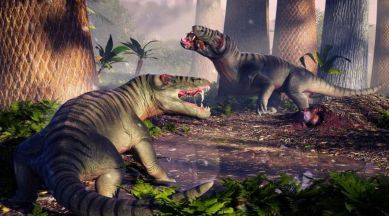Pampaphoneus biccai is the oldest and largest predator whose fossils were discovered in South America.

The words ancient predator probably conjure up images of dinosaurs, most notably, the T.rex. But much before the age of dinosaurs, 40 million years before in fact, Pampaphoneus biccai roamed South America as the biggest and most dangerous predator of its time.
An international team of researchers documented the discovery of a 265-million-year-old fossil of the species found in Brazil in the Zoological Journal of the Linnean Society. The extraordinary fossil specimen includes a complete skill and some skeletal bones like ribs and arm bones. Pampaphoneus lived just before the largest extinction event in the history of Earth. That event eliminated 86 per cent of all animal species across the globe.
Ahead of the extinction event, dinocephalians were some of the largest groups of land animals that thrived. The group involved medium to large-sized creatures, some carnivorous and some herbivorous. They were fairly common in South Africa and Russia but seems to have been much rarer in other parts of the world. Pampaphoneus biccai are the only known species of the group that existed in what is now Brazil.
You have exhausted your
monthly limit of free stories.
To continue reading,
simply register or sign in
Continue reading with an Indian Express Premium membership.
This premium article is free for now.
Register to read more free stories and access offers from partners.
Continue reading with an Indian Express Premium membership.
This content is exclusive for our subscribers.
Subscribe now to get unlimited access to The Indian Express exclusive and premium stories.
Most Read
“The fossil was found in middle Permian rocks, in an area where bones are not so common, but always hold pleasant surprises. Finding a new Pampaphoneus skull after so long was extremely important for increasing our knowledge about the animal, which was previously difficult to differentiate from its Russian relatives,” said lead author Mateus A Costa Santos, in a statement.
According to co-author Stephanie E Pierce, the animal must have been a gnarly-looking beast, evoking sheer dread in anything that crossed its path.
The Pampaphoneus skull is the second ever discovered in South America. Not only is it larger than the first but it also provides much more information about the animal’s physical shape and structure because of how well preserved the bones are.
© IE Online Media Services Pvt Ltd
First published on: 13-09-2023 at 13:08 IST






